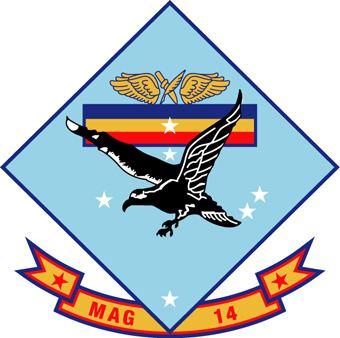Active N/A Type Fixed Wing | Country United States | |
 | ||
Allegiance United States of America Role Offensive Air SupportAerial ReconnaissanceElectronic WarfareAssault Support | ||
Marine Aircraft Group 14 (MAG-14) is a United States Marine Corps aviation unit based at Marine Corps Air Station Cherry Point, North Carolina that is currently composed of four AV-8B Harrier squadrons, four EA-6B Prowler squadrons, one KC-130 squadron, a maintenance and logistics squadron, and a wing support squadron.
Contents
Mission
Conduct offensive air support, anti-air warfare, electronic warfare, assault support, and air reconnaissance operations in support of the Marine Air-Ground Task Force or joint and coalition forces, and conduct fleet replacement program training in order to provide combat capable aircrews to operational squadrons.
Subordinate units
AV-8B Harrier squadrons
EA-6B Prowler squadrons
UAV squadron
KC-130 Squadron
Maintenance squadron
Wing support squadron
World War II
Marine Aircraft Group 14 was formed at then Camp Kearny, California on 1 March 1942. The nucleus for the new aircraft group came from Marine Aircraft Group 11 which had just arrived from Marine Corps Air Station Quantico following the 7 December 1941 attack on Pearl Harbor. They remained there training until they deployed for the Pacific Theater in October 1942. The Group soon arrived at Guadalcanal relieving Marine Aircraft Group 23 on 16 October 1942 to become part of the Cactus Air Force. The group would take part in the Battle of the Santa Cruz Islands just 10 days later. In November 1942 they took part in the Naval Battle of Guadalcanal and continued to fight in the skies over the island until 4 April 1943 when they were sent to Auckland, New Zealand to rest and refit.
MAG-14 returned to the Solomon Islands in August 1943 and set up the Fighter Command at Munda. The next month part of the group was moved to Ondonga and later on more units were sent to Vella Lavella. From these locations they supported the Marines and American and Allied soldiers during the Battle of New Georgia and the Battle of Bougainville.
On 15 February 1944 New Zealand troops captured the Green Islands in Papua New Guinea. Less than two weeks later aircraft from MAG-14 were operating from the airstrip here known as Lagoon Field. From here, MAG-14 units would continue to keep pressure on the isolated Japanese garrisons of Rabaul and Kavieng.
By 24 January 1945, four fighter squadrons from MAG-14 were operating from Guiuan in the northern Philippines province of Eastern Samar. During fighting in the Philippines the Group was responsible for covering convoys and supporting Army and Filipino guerillas on the islands of Negros, Mindanao, Cebu and Leyte.
Following the war the Group returned to Marine Corps Auxiliary Airfield Oak Grove in February 1946 and was deactivated.
The Gulf War & the 1990s
During Operation Desert Storm, MAG-14 flew night combat missions deep into Iraq and Kuwait and provided artillery destruction of the Iraqi Republican Guard. VMA-231 and VMA-542 provided more than 2,000 offensives in conjunction with delivering close to 4.5 million pounds of ordnance during January and February 1991.
In November 1999, Marine Unmanned Aerial Vehicle Squadron-2 (VMU-2), which operates the RQ-2A Pioneer Unmanned Aerial Vehicle was reassigned from MAG-14 to Marine Air Control Group 28 (MACG-28) at the decision of the USMC Force Structure Planning Group.
